Imaging Ocean-Bottom Seismic Data with Acoustic Kirchhoff Pre-Stack Depth Migration: A Numerical Investigation of Migration Responses and Crosstalk Artifacts
Abstract
1. Introduction
2. Methodology
2.1. A Graphic Dissection of Typical OBS Events
2.2. Numerical Simulation of OBS Events Based on the FD Method
2.3. Kirchhoff Pre-Stack Depth Migration
2.4. The Numerical Investigation Workflow
3. An Integrated Investigation with Numerical Examples
3.1. Migration Responses
3.1.1. Migration Responses of Kirchhoff PSDM for Primary (P-Wave) Reflections
3.1.2. Mirror Migration Responses
3.1.3. Imaging Elastic-Wave Reflections
3.2. Wave-Mode Crosstalks and Artifact Characteristics
3.2.1. WLRM Crosstalk Artifacts
3.2.2. Using WLRMs as Effective Signals Through the Mirror Kirchhoff Migration
3.2.3. PP and PS Imaging with Acoustic Kirchhoff PSDM
3.3. Extended Applications to Sparse OBN Data: The Truncated Marmousi2 Model Example
3.3.1. Conventional Migration of Acoustic Pressure Component
3.3.2. Migration and Mirror Migration of Elastic Pressures After the Up-/Down-Going Separation
3.3.3. Joint PP and PS Migration of Separated Elastic P and S Data
4. Discussion
5. Conclusions
Author Contributions
Funding
Institutional Review Board Statement
Informed Consent Statement
Data Availability Statement
Acknowledgments
Conflicts of Interest
Abbreviations
| OBS | Ocean-bottom seismic |
| OBN | Ocean-bottom node |
| WLRM | Water-layer-related multiple |
| PSDM | Pre-stack depth migration |
| ADCIGs | Angle-domain common image gathers |
| CRG | Common-receiver gather |
References
- Ikelle, L.T.; Amundsen, L. Introduction to Petroleum Seismology; Society of Exploration Geophysicists: Houston, TX, USA, 2018. [Google Scholar]
- Wang, H.; Xiang, J.; Shi, Y. Basic logic and key methods of OBN seismic data imaging processing. Geophys. Prospect. Pet. 2024, 63, 12–29. (In Chinese) [Google Scholar]
- Wang, T.; Liu, X.; Cheng, J. Wave modes of multi-component OBC/OBN data under typical water depth and bottom medium conditions. Geophys. Prospect. Pet. 2024, 63, 45–60. (In Chinese) [Google Scholar]
- Beylkin, G. Imaging of discontinuities in the inverse scattering problem by inversion of a causal generalized Radon transform. J. Math. Phys. 1985, 26, 99–108. [Google Scholar] [CrossRef]
- Bleistein, N.; Stockwell, J.; Cohen, J. Multidimensional seismic inversion. In Mathematics of Multidimensional Seismic Imaging, Migration, and Inversion; Springer: New York, NY, USA; Berlin/Heidelberg, Germany, 2001. [Google Scholar]
- Kuo, J.T.; Dai, T.f. Kirchhoff elastic wave migration for the case of noncoincident source and receiver. Geophysics 1984, 49, 1223–1238. [Google Scholar] [CrossRef]
- Hokstad, K. Multicomponent Kirchhoff migration. Geophysics 2000, 65, 861–873. [Google Scholar] [CrossRef]
- Du, Q.; Li, F.; Ba, J.; Zhu, Y.; Hou, B. Multicomponent joint migration velocity analysis in the angle domain for PP-waves and PS-waves. Geophysics 2012, 77, U1–U13. [Google Scholar] [CrossRef]
- Protasov, M.; Tcheverda, V. True amplitude elastic Gaussian beam imaging of multicomponent walkaway vertical seismic profiling data. Geophys. Prospect. 2012, 60, 1030–1042. [Google Scholar] [CrossRef]
- Casasanta, L.; Gray, S.H. Converted-wave beam migration with sparse sources or receivers. Geophys. Prospect. 2015, 63, 534–551. [Google Scholar] [CrossRef]
- Li, X.; Mao, W.; Shi, X.; Yue, Y. Elastic 3D PS converted-wave Gaussian beam migration. Geophysics 2018, 83, S213–S225. [Google Scholar] [CrossRef]
- Shi, X.; Mao, W.; Li, X. Elastic Gaussian-beam migration for four-component ocean-bottom seismic data. Geophysics 2020, 85, S11–S19. [Google Scholar] [CrossRef]
- Xie, X.B.; Wu, R.S. Multicomponent prestack depth migration using the elastic screen method. Geophysics 2005, 70, S30–S37. [Google Scholar] [CrossRef]
- Stanton, A.; Sacchi, M.D. Elastic least-squares one-way wave-equation migration. Geophysics 2017, 82, S293–S305. [Google Scholar] [CrossRef]
- Ravasi, M.; Curtis, A. Elastic imaging with exact wavefield extrapolation for application to ocean-bottom 4C seismic data. Geophysics 2013, 78, S265–S284. [Google Scholar] [CrossRef]
- Yu, P.; Geng, J.; Li, X.; Wang, C. Acoustic-elastic coupled equation for ocean bottom seismic data elastic reverse time migration. Geophysics 2016, 81, S333–S345. [Google Scholar] [CrossRef]
- Han, B.; Mao, W.; Xie, X.B. Acoustic/elastic wavefield injection and reconstruction from ocean-bottom data for elastic RTM. In Proceedings of the Fourth International Meeting for Applied Geoscience & Energy, Houston, TX, USA, 26–29 August 2024; Society of Exploration Geophysicists: Houston, TX, USA, 2024; pp. 2239–2243. [Google Scholar]
- Huang, R.; Zhang, Z.; Wu, Z.; Wei, Z.; Mei, J.; Wang, P. Full-waveform inversion for full-wavefield imaging: Decades in the making. Lead. Edge 2021, 40, 324–334. [Google Scholar] [CrossRef]
- Jin, H.; Luo, S.; Liao, Q.; Shen, X.; Xia, G.; Vyas, M. FWI derived reflectivity gathers in angle domain. In Proceedings of the Fourth International Meeting for Applied Geoscience & Energy, Houston, TX, USA, 26–29 August 2024; Society of Exploration Geophysicists: Houston, TX, USA, 2024; pp. 935–939. [Google Scholar]
- Cheng, X.; Mao, J.; Feng, Z.; Vigh, D.; Glaccum, K.; Yu, Y. Advancing seismic imaging: From kinematics to dynamics with elastic full-waveform inversion. Lead. Edge 2025, 44, 362–370. [Google Scholar] [CrossRef]
- Hou, A.; Marfurt, K.J. Multicomponent prestack depth migration by scalar wavefield extrapolation. Geophysics 2002, 67, 1886–1894. [Google Scholar] [CrossRef]
- Zhang, D.; Tsingas, C.; Ghamdi, A.A.; Huang, M.; Jeong, W.; Sliz, K.K.; Aldeghaither, S.M.; Zahrani, S.A. A review of OBN processing: Challenges and solutions. J. Geophys. Eng. 2021, 18, 492–502. [Google Scholar] [CrossRef]
- Osen, A.; Amundsen, L.; Reitan, A. Removal of water-layer multiples from multicomponent sea-bottom data. Geophysics 1999, 64, 838–851. [Google Scholar] [CrossRef]
- Muijs, R.; Robertsson, A.J.O.; Holliger, K. Prestack depth migration of primary and surface-related multiple reflections: Part II—Identification and removal of residual multiples. Geophysics 2007, 72, S71–S76. [Google Scholar] [CrossRef]
- Yu, P.; Chu, M.; Jiang, J. Multicomponent ocean-bottom seismic data decomposition using separate calibration filters. Pure Appl. Geophys. 2023, 180, 41–57. [Google Scholar] [CrossRef]
- Amundsen, L.; Ikelle, L.T.; Martin, J. Multiple attenuation and P/S splitting of multicomponent OBC data at a heterogeneous sea floor. Wave Motion 2000, 32, 67–78. [Google Scholar] [CrossRef]
- Schalkwijk, K.; Wapenaar, C.; Verschuur, D. Adaptive decomposition of multicomponent ocean-bottom seismic data into downgoing and upgoing P-and S-waves. Geophysics 2003, 68, 1091–1102. [Google Scholar] [CrossRef]
- Wang, T.; Liu, X.; Cheng, J. Converted-wave reflection traveltime inversion with free-surface multiples for ocean-bottom-node data. Geophysics 2024, 89, U1–U15. [Google Scholar] [CrossRef]
- Liu, Y.; Zhong, Y.; Liu, K.; Hua, Q. Seafloor elastic-parameter estimation based on a regularized AVO inversion method. Mar. Geophys. Res. 2020, 41, 5. [Google Scholar] [CrossRef]
- Chen, G.; Li, J.; Chen, J.; Du, R.; Liu, Y.; Qi, Y.; Li, C.F.; Huang, X. High-precision sub-seafloor velocity building based on joint tomography and deep learning on OBS data in the South China Sea. J. Earth Sci. 2025, 36, 830–834. [Google Scholar] [CrossRef]
- Wiggins, J.W. Attenuation of complex water-bottom multiples by wave-equation-based prediction and subtraction. Geophysics 1988, 53, 1527–1539. [Google Scholar] [CrossRef]
- Spadavecchia, E.; Lipari, V.; Bienati, N.; Drufuca, G. Water-bottom multiple attenuation by Kirchhoff extrapolation. Geophys. Prospect. 2013, 61, 725–734. [Google Scholar] [CrossRef]
- Xiang, J.; Wang, H.; Wu, C.; Feng, B. Prediction method for water-layer-related multiple of rugged seabed based on Born simulation using phase shift operator. IEEE Trans. Geosci. Remote Sens. 2025, 63, 5911912. [Google Scholar] [CrossRef]
- Foster, D.J.; Mosher, C.C. Suppression of multiple reflections using the Radon transform. Geophysics 1992, 57, 386–395. [Google Scholar] [CrossRef]
- Schonewille, M.; Aaron, P. Applications of time-domain high-resolution Radon demultiple. In SEG Technical Program Expanded Abstracts 2007; Society of Exploration Geophysicists: Houston, TX, USA, 2007; pp. 2565–2569. [Google Scholar]
- Song, H.; Mao, W.; Tang, H.; Xu, Q.; Ouyang, W. Multiple attenuation based on connected-component analysis and high-resolution parabolic Radon transform. J. Appl. Geophys. 2022, 199, 104580. [Google Scholar] [CrossRef]
- Berkhout, A.J.; Verschuur, D. Estimation of multiple scattering by iterative inversion, Part I: Theoretical considerations. Geophysics 1997, 62, 1586–1595. [Google Scholar] [CrossRef]
- Verschuur, D.J.; Berkhout, A.; Wapenaar, C. Adaptive surface-related multiple elimination. Geophysics 1992, 57, 1166–1177. [Google Scholar] [CrossRef]
- Weglein, A.B.; Gasparotto, F.A.; Carvalho, P.M.; Stolt, R.H. An inverse-scattering series method for attenuating multiples in seismic reflection data. Geophysics 1997, 62, 1975–1989. [Google Scholar] [CrossRef]
- Ikelle, L.T.; Amundsen, L.; Gangi, A.; Wyatt, S.B. Kirchhoff scattering series: Insight into the multiple attenuation method. Geophysics 2003, 68, 16–28. [Google Scholar] [CrossRef]
- Innanen, K.A. Born series forward modelling of seismic primary and multiple reflections: An inverse scattering shortcut. Geophys. J. Int. 2009, 177, 1197–1204. [Google Scholar] [CrossRef]
- Ravasi, M. Rayleigh-Marchenko redatuming for target-oriented, true-amplitude imaging. Geophysics 2017, 82, S439–S452. [Google Scholar] [CrossRef]
- Singh, S.; Snieder, R.; van der Neut, J.; Thorbecke, J.; Slob, E.; Wapenaar, K. Accounting for free-surface multiples in Marchenko imaging. Geophysics 2017, 82, R19–R30. [Google Scholar] [CrossRef]
- Li, Z.; Sun, N.; Gao, H.; Qin, N.; Li, Z. Adaptive subtraction based on U-Net for removing seismic multiples. IEEE Trans. Geosci. Remote Sens. 2021, 59, 9796–9812. [Google Scholar] [CrossRef]
- Kiraz, M.S.; Snieder, R.; Sheiman, J. Attenuating free-surface multiples and ghost reflection from seismic data using a trace-by-trace convolutional neural network approach. Geophys. Prospect. 2024, 72, 908–937. [Google Scholar] [CrossRef]
- Durall, R.; Ghanim, A.; Ettrich, N.; Keuper, J. An in-depth study of U-net for seismic data conditioning: Multiple removal by moveout discrimination. Geophysics 2024, 89, WA233–WA246. [Google Scholar] [CrossRef]
- Fernandez, M.R.; Ettrich, N.; Delescluse, M.; Rabaute, A.; Keuper, J. Towards deep learning for seismic demultiple. Geophys. Prospect. 2025, 73, 1185–1203. [Google Scholar] [CrossRef]
- Etgen, J.T.; O’Brien, M.J. Computational methods for large-scale 3D acoustic finite-difference modeling: A tutorial. Geophysics 2007, 72, SM223–SM230. [Google Scholar] [CrossRef][Green Version]
- Liu, F.; Zhang, G.; Morton, S.A.; Leveille, J.P. An effective imaging condition for reverse-time migration using wavefield decomposition. Geophysics 2011, 76, S29–S39. [Google Scholar] [CrossRef]
- Yoon, K.; Marfurt, K.J. Reverse-time migration using the Poynting vector. Explor. Geophys. 2006, 37, 102–107. [Google Scholar] [CrossRef]
- Han, B.; Xie, X.B.; Liu, S.; Mao, W. Modelling separated orders of free-surface multiples by sequential finite-difference propagators and its applications to multiple imaging. In Proceedings of the 86th EAGE Annual Conference & Exhibition, Toulouse, France, 2–5 June 2025; European Association of Geoscientists & Engineers: Toulouse, France; Volume 2025, pp. 1–5. [Google Scholar]
- Biondi, E.; Meadows, M.A.; Biondi, B. True-amplitude migration through regularized extended linearized waveform inversion. Geophysics 2022, 87, S1–S20. [Google Scholar] [CrossRef]
- Stolt, R.H.; Weglein, A.B. Seismic Imaging and Inversion: Volume 1: Application of Linear Inverse Theory; Cambridge University Press: Cambridge, UK, 2012. [Google Scholar]
- De Basabe, J.D.; Sen, M.K. A comparison of finite-difference and spectral-element methods for elastic wave propagation in media with a fluid-solid interface. Geophys. J. Int. 2015, 200, 278–298. [Google Scholar] [CrossRef]
- Qu, Y.; Huang, J.; Li, Z.; Li, J. A hybrid grid method in an auxiliary coordinate system for irregular fluid-solid interface modeling. Geophys. J. Int. 2016, 208, 1540–1556. [Google Scholar] [CrossRef]
- Sun, Y.C.; Zhang, W.; Xu, J.K.; Chen, X. Numerical simulation of 2-D seismic wave propagation in the presence of a topographic fluid–solid interface at the sea bottom by the curvilinear grid finite-difference method. Geophys. J. Int. 2017, 210, 1721–1738. [Google Scholar] [CrossRef]
- Sethi, H.; Shragge, J.; Tsvankin, I. Mimetic finite-difference coupled-domain solver for anisotropic media. Geophysics 2021, 86, T45–T59. [Google Scholar] [CrossRef]
- Ronen, S.; Comeaux, L.; Miao, X.G. Imaging downgoing waves from ocean bottom stations. In SEG Technical Program Expanded Abstracts 2005; Society of Exploration Geophysicists: Houston, TX, USA, 2005; pp. 963–966. [Google Scholar]
- Grion, S.; Exley, R.; Manin, M.; Miao, X.; Pica, A.; Wang, Y.; Granger, P.; Ronen, S. Mirror imaging of OBS data. First Break 2007, 25, 37–42. [Google Scholar] [CrossRef]
- Dash, R.; Spence, G.; Hyndman, R.; Grion, S.; Wang, Y.; Ronen, S. Wide-area imaging from OBS multiples. Geophysics 2009, 74, Q41–Q47. [Google Scholar] [CrossRef][Green Version]
- Ravasi, M.; Vasconcelos, I.; Curtis, A.; Kritski, A. Vector-acoustic reverse time migration of Volve ocean-bottom cable data set without up/down decomposed wavefields. Geophysics 2015, 80, S137–S150. [Google Scholar] [CrossRef]
- Jamali H, E.; Katou, M.; Tara, K.; Asakawa, E.; Mikada, H. Mirror reverse time migration using vertical cable seismic data for methane hydrate exploration. Geophysics 2019, 84, B447–B460. [Google Scholar] [CrossRef]
- Zhong, Y.; Gu, H.; Liu, Y.; Mao, Q. A new joint reverse time migration method to improve vertical seismic profile image quality. J. Pet. Sci. Eng. 2022, 214, 110546. [Google Scholar] [CrossRef]
- Grion, S.; Böhm, G.; Rossi, G.; Tinivella, U.; Mazzotti, A. Tomographic and AVO analyses of bottom simulating reflectors (BSR) on real data. In SEG Technical Program Expanded Abstracts 1997; Society of Exploration Geophysicists: Houston, TX, USA, 1997; pp. 171–174. [Google Scholar]
- Chen, M.A.P.; Riedel, M.; Hyndman, R.D.; Dosso, S.E. AVO inversion of BSRs in marine gas hydrate studies. Geophysics 2007, 72, C31–C43. [Google Scholar] [CrossRef]
- Shi, S.; Zhan, L.; Cai, W.; Yang, R.; Lu, H. Bottom-Simulating Reflectors (BSRs) in Gas Hydrate Systems: A Comprehensive Review. J. Mar. Sci. Eng. 2025, 13, 1137. [Google Scholar] [CrossRef]
- Martin, G.S.; Wiley, R.; Marfurt, K.J. Marmousi2: An elastic upgrade for Marmousi. Lead. Edge 2006, 25, 156–166. [Google Scholar] [CrossRef]
- Sava, P.; Guitton, A. Multiple attenuation in the image space. Geophysics 2005, 70, V10–V20. [Google Scholar] [CrossRef]
- Wang, Y.; Zheng, Y.; Zhang, L.; Chang, X.; Yao, Z. Reverse time migration of multiples: Eliminating migration artifacts in angle domain common image gathers. Geophysics 2014, 79, S263–S270. [Google Scholar] [CrossRef]
- Protasov, M.; Yarman, C.; Nichols, D.; Osypov, K.; Cheng, X. Frequency-dependent ray-tracing through rugose interfaces. In SEG Technical Program Expanded Abstracts 2011; Society of Exploration Geophysicists: Houston, TX, USA, 2011; pp. 2992–2996. [Google Scholar]
- Yarman, C.E.; Cheng, X.; Osypov, K.; Nichols, D.; Protasov, M. Band-limited ray tracing. Geophys. Prospect. 2013, 61, 1194–1205. [Google Scholar] [CrossRef]
- Liu, S.; Gu, H.; Han, B.; Yan, Z.; Liu, D.; Cai, J. Band-limited beam propagator and its application to seismic migration. Geophysics 2018, 83, S311–S319. [Google Scholar] [CrossRef]
- Etgen, J.T. 3D wave equation Kirchhoff migration. In SEG Technical Program Expanded Abstracts 2012; Society of Exploration Geophysicists: Houston, TX, USA, 2012; pp. 1–5. [Google Scholar]
- Jin, H.; Etgen, J. Evaluating Kirchhoff migration using wave-equation generated maximum amplitude traveltimes. In SEG Technical Program Expanded Abstracts 2020; Society of Exploration Geophysicists: Houston, TX, USA, 2020; pp. 2968–2972. [Google Scholar]
- Wang, Y.; He, Y.; Yeh, A.; Liu, F.; Wang, B.; Calderón, C. Improve Kirchhoff depth imaging using full-wave-equation traveltimes. In Proceedings of the Third International Meeting for Applied Geoscience & Energy, Houston, TX, USA, 28 August–1 September 2023; Society of Exploration Geophysicists: Houston, TX, USA, 2023; pp. 1598–1602. [Google Scholar]
- Cunha, C.; Ritter, G.; Sardinha, A.; Dias, B.P.; Guerra, C.; Thedy, F.; Hargreaves, N.; Coacci, R. Multi-image, reverse time, and Kirchhoff migrations with compact Green’s functions. Geophysics 2024, 89, S99–S118. [Google Scholar] [CrossRef]
- Rastogi, R.; Londhe, A.; Srivastava, A.; Sirasala, K.M.; Khonde, K. 3D Kirchhoff depth migration algorithm: A new scalable approach for parallelization on multicore CPU based cluster. Comput. Geosci. 2017, 100, 67–75. [Google Scholar] [CrossRef]
- Basnet, M.B.; Anas, M.; Rizvi, Z.H.; Ali, A.H.; Zain, M.; Cascante, G.; Wuttke, F. Enhancement of in-plane seismic full waveform inversion with CPU and GPU parallelization. Appl. Sci. 2022, 12, 8844. [Google Scholar] [CrossRef]
- Liu, Y.; Liu, H.; He, Y.; Qin, F.; Du, Y. Accelerated Kirchhoff depth migration on CPU-GPU heterogeneous computing systems. In Proceedings of the SEG International Exposition and Annual Meeting, Houston, TX, USA, 28 August–1 September 2022; Society of Exploration Geophysicists: Houston, TX, USA, 2022; pp. 2724–2728. [Google Scholar]
- Robertsson, J.O.; Laws, R.; Chapman, C.; Vilotte, J.P.; Delavaud, E. Modelling of scattering of seismic waves from a corrugated rough sea surface: A comparison of three methods. Geophys. J. Int. 2006, 167, 70–76. [Google Scholar] [CrossRef]
- Orji, O.C.; Söllner, W.; Gelius, L.J. Effects of time-varying sea surface in marine seismic data. Geophysics 2012, 77, P33–P43. [Google Scholar] [CrossRef]
- Blacquière, G.; Sertlek, H.Ö. Modeling and assessing the effects of the sea surface, from being flat to being rough and dynamic. Geophysics 2019, 84, T13–T27. [Google Scholar] [CrossRef]
- Konuk, T.; Shragge, J. Modeling full-wavefield time-varying sea-surface effects on seismic data: A mimetic finite-difference approach. Geophysics 2020, 85, T45–T55. [Google Scholar] [CrossRef]
- Han, B.; Xie, X.B. The effect of free-surface reflections on depth images for acquisition with buried sources and receivers: Investigation through the point spread function. Geophys. Prospect. 2023, 71, 414–430. [Google Scholar] [CrossRef]
- Deeks, J.; Lumley, D. Prism waves in seafloor canyons and their effects on seismic imaging. Geophysics 2015, 80, S213–S222. [Google Scholar] [CrossRef]
- Ursin, B.; Favretto-Cristini, N.; Cristini, P. Amplitude and phase changes for reflected and transmitted waves from a curved interface in anisotropic media. Geophys. J. Int. 2021, 224, 719–737. [Google Scholar] [CrossRef]
- Wong, M.; Biondi, B.L.; Ronen, S. Imaging with primaries and free-surface multiples by joint least-squares reverse time migration. Geophysics 2015, 80, S223–S235. [Google Scholar] [CrossRef]
- Yang, J.; Huang, J.; Zhu, H.; Li, Z.; Lu, S.; Mao, W.; Zhou, H.; Qin, N.; Tian, K. Review on the progress of least-squares migration in exploration seismology. Rev. Geophys. Planet. Phys. 2025, 56, 1–29. (In Chinese) [Google Scholar]
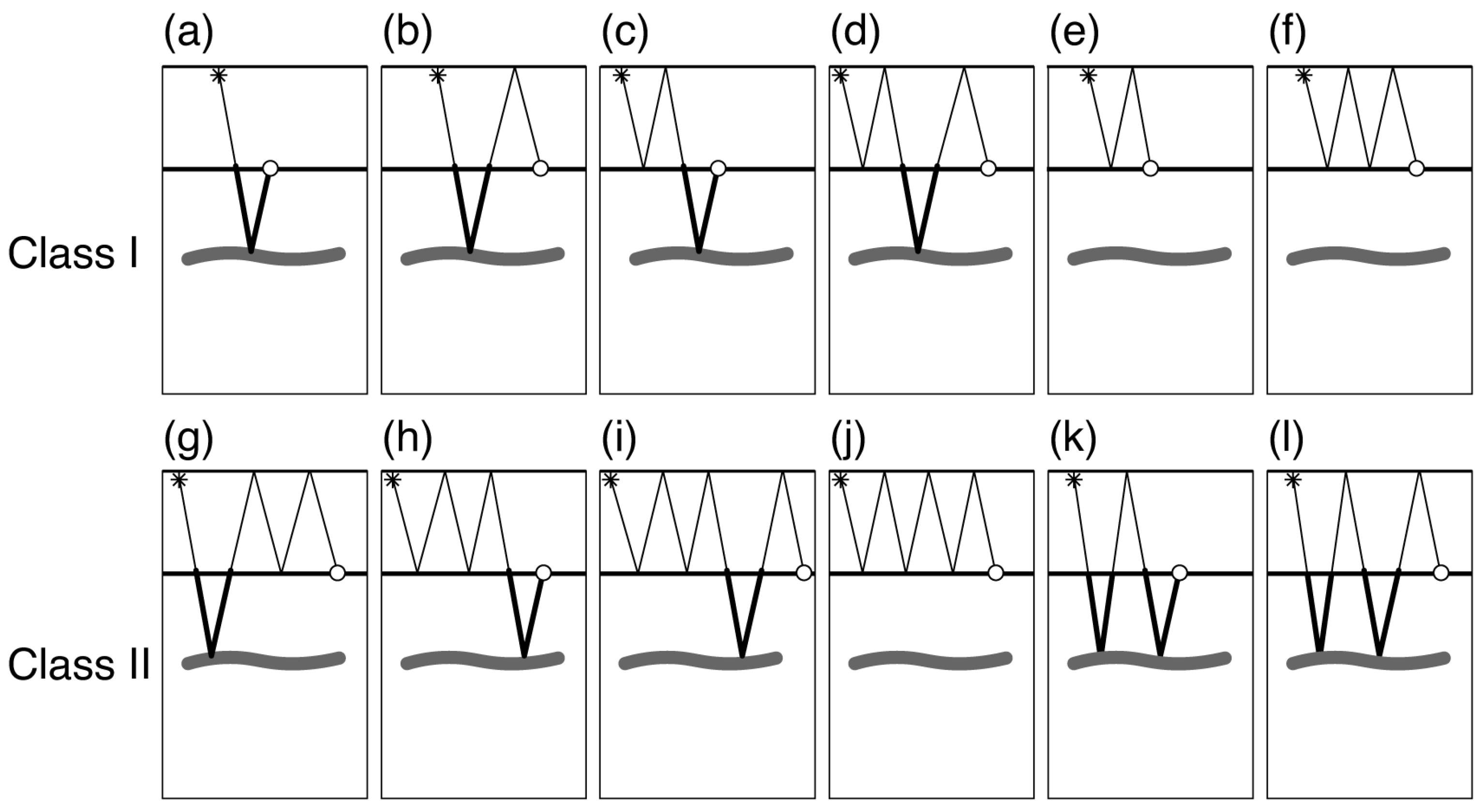
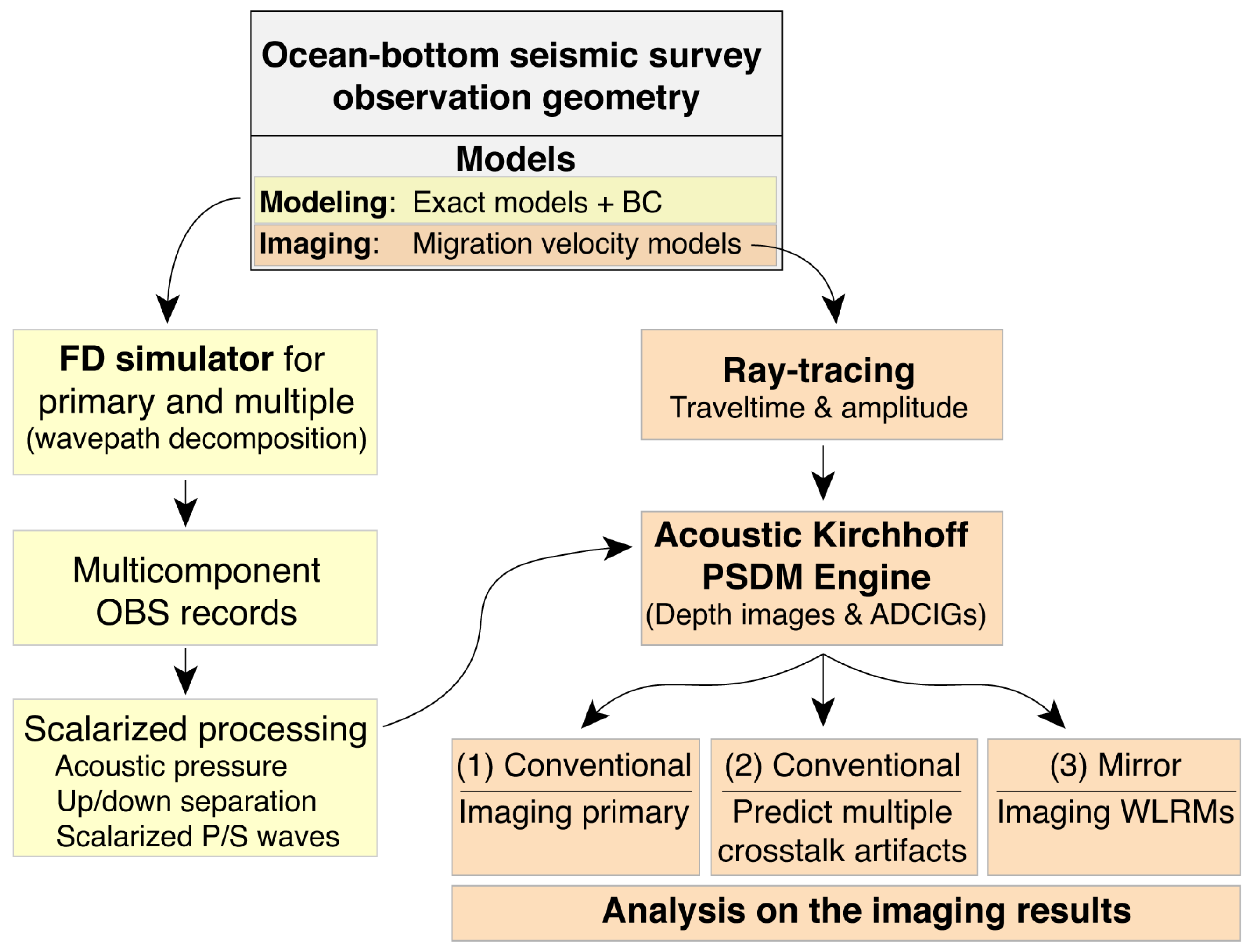



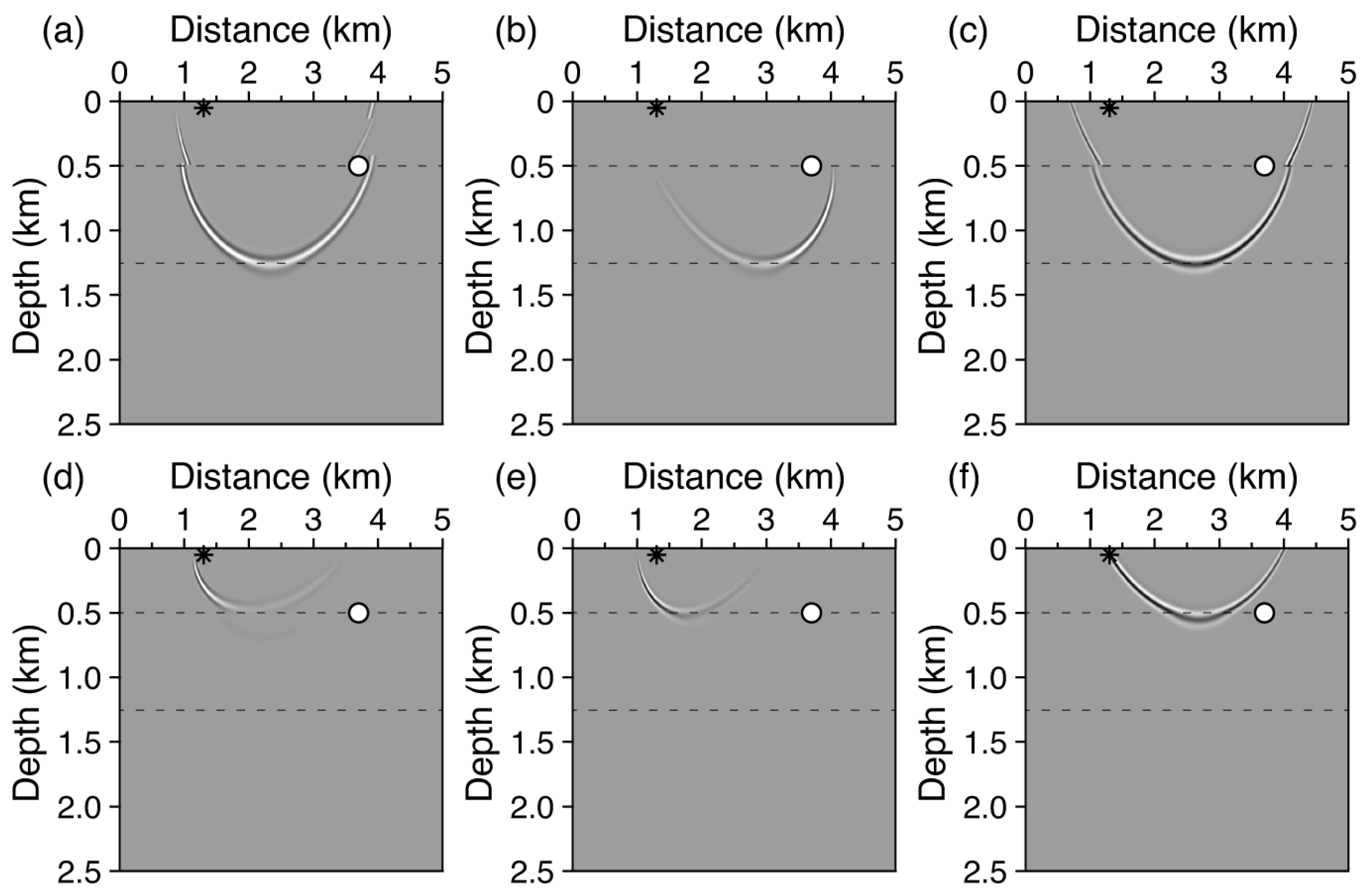

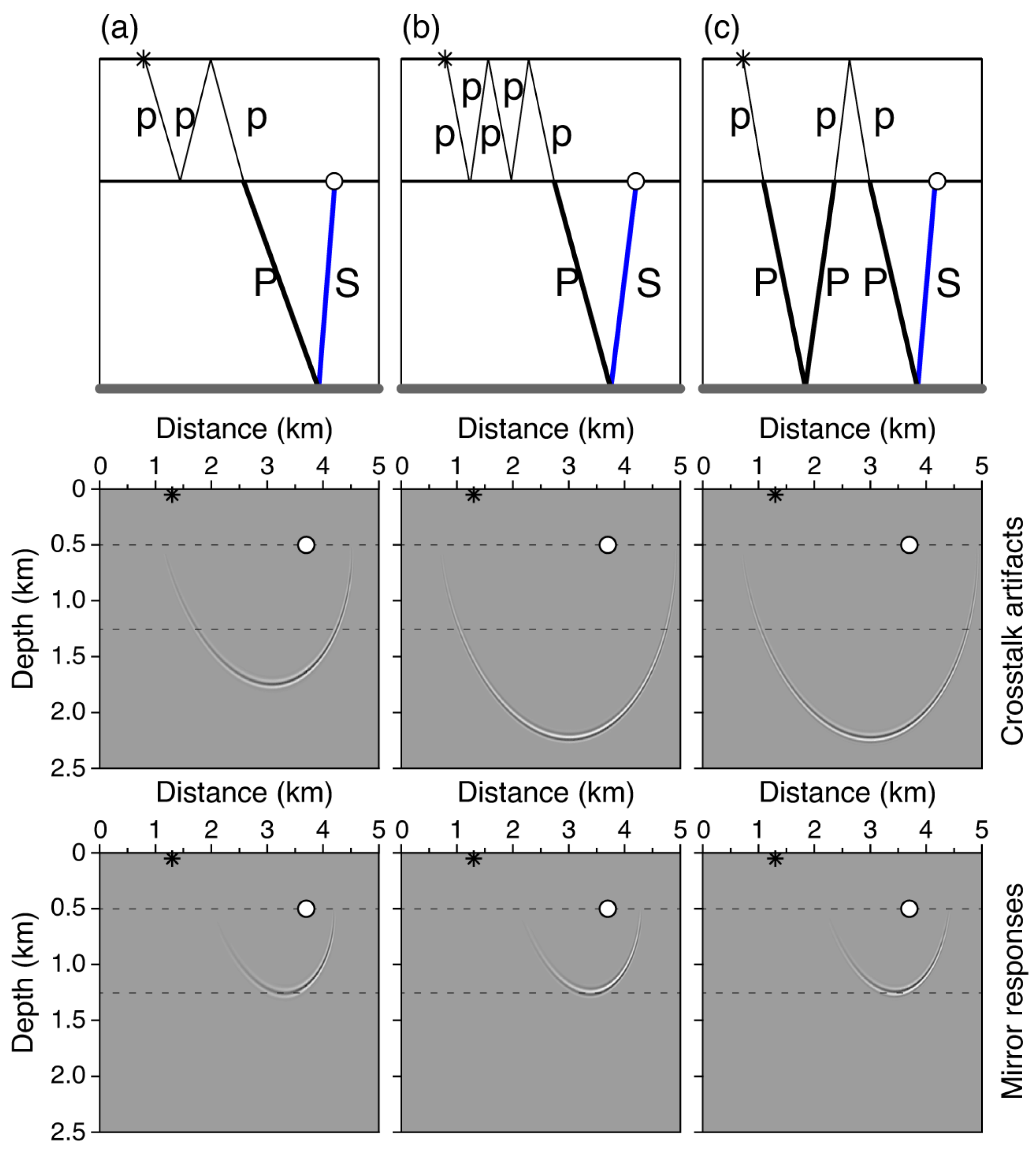

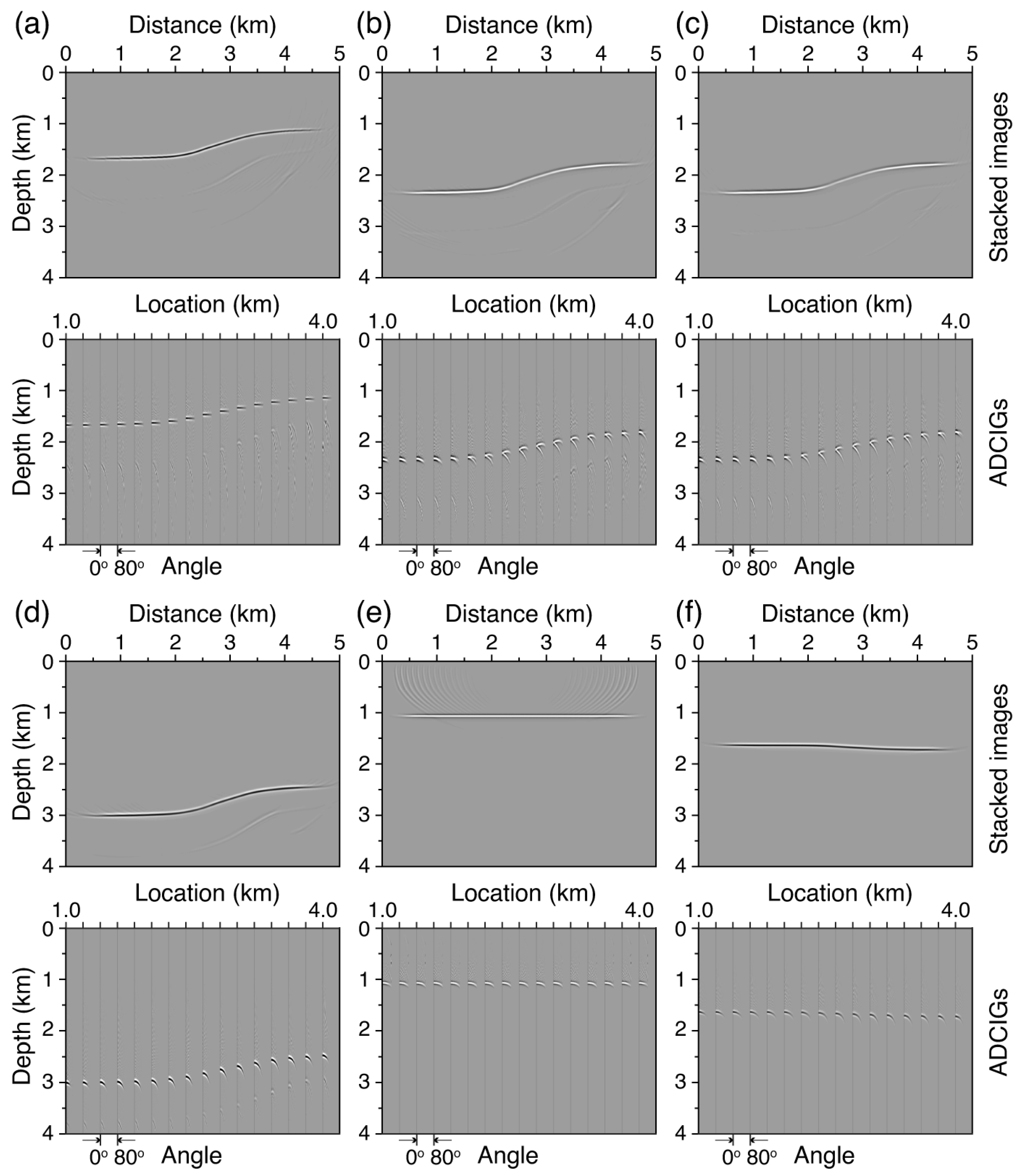
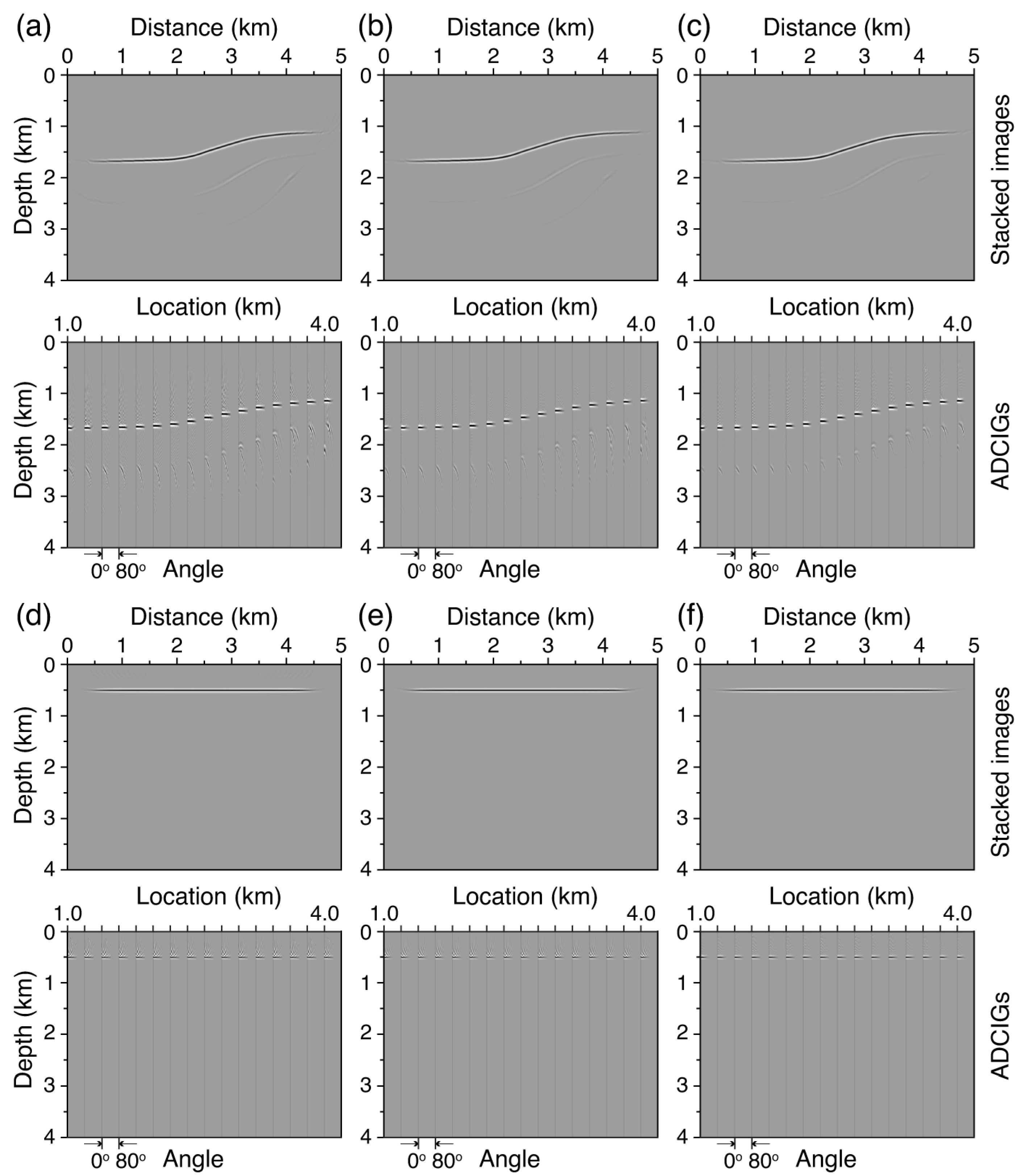
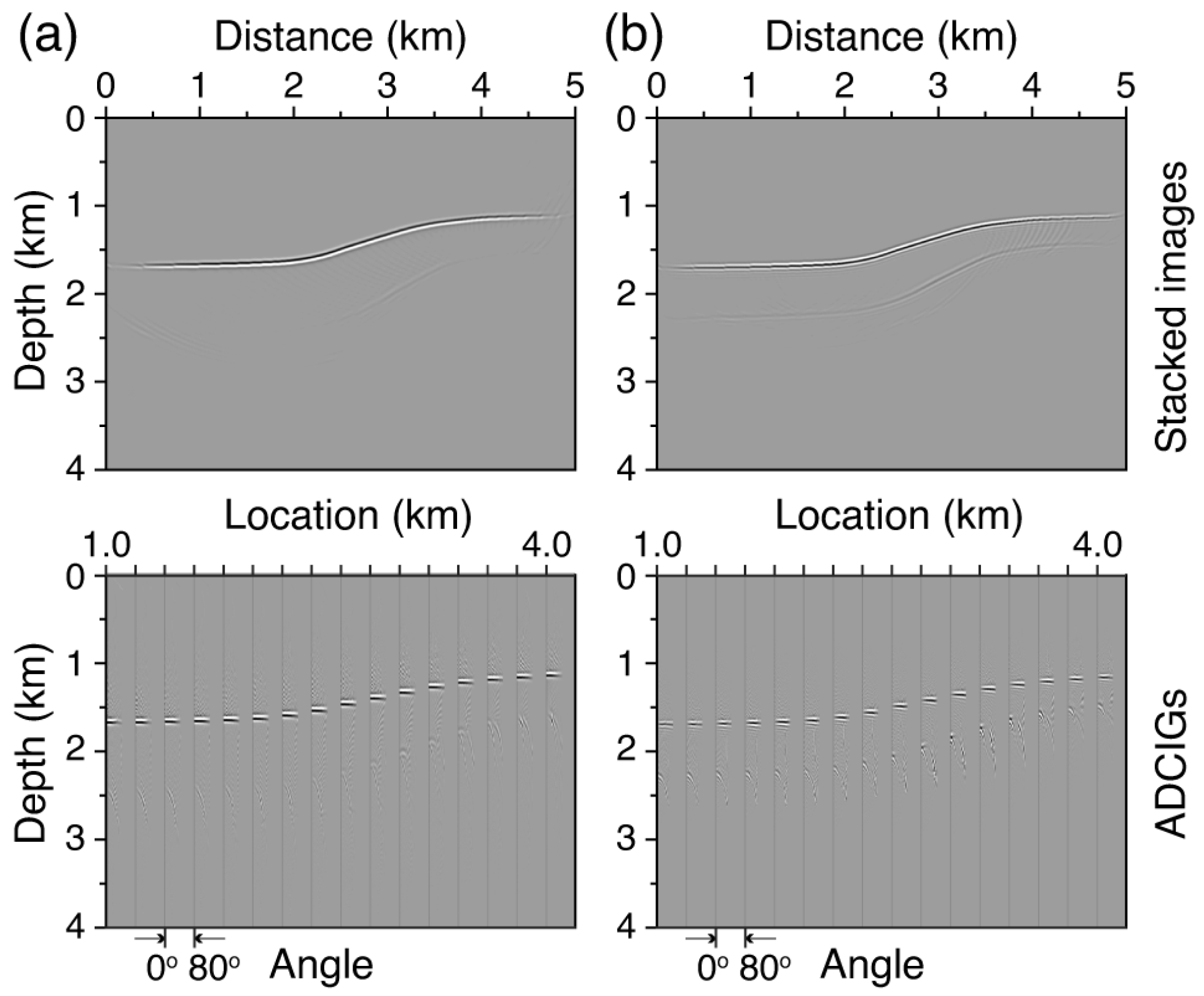
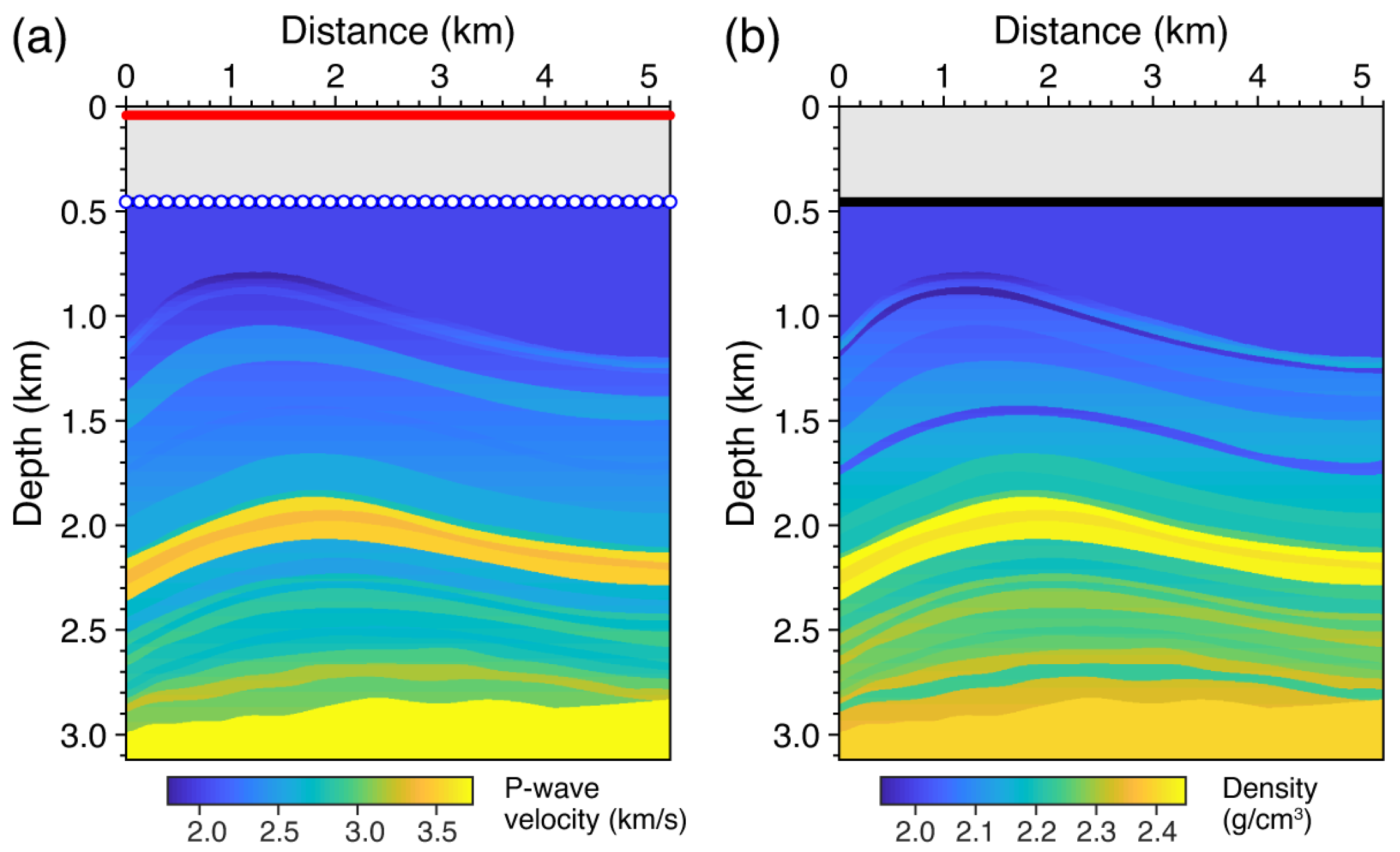


Disclaimer/Publisher’s Note: The statements, opinions and data contained in all publications are solely those of the individual author(s) and contributor(s) and not of MDPI and/or the editor(s). MDPI and/or the editor(s) disclaim responsibility for any injury to people or property resulting from any ideas, methods, instructions or products referred to in the content. |
© 2025 by the authors. Licensee MDPI, Basel, Switzerland. This article is an open access article distributed under the terms and conditions of the Creative Commons Attribution (CC BY) license (https://creativecommons.org/licenses/by/4.0/).
Share and Cite
Han, B.; Liang, Q.; Mao, W.; Chen, G. Imaging Ocean-Bottom Seismic Data with Acoustic Kirchhoff Pre-Stack Depth Migration: A Numerical Investigation of Migration Responses and Crosstalk Artifacts. J. Mar. Sci. Eng. 2025, 13, 2109. https://doi.org/10.3390/jmse13112109
Han B, Liang Q, Mao W, Chen G. Imaging Ocean-Bottom Seismic Data with Acoustic Kirchhoff Pre-Stack Depth Migration: A Numerical Investigation of Migration Responses and Crosstalk Artifacts. Journal of Marine Science and Engineering. 2025; 13(11):2109. https://doi.org/10.3390/jmse13112109
Chicago/Turabian StyleHan, Bingkai, Quan Liang, Weijian Mao, and Guoxin Chen. 2025. "Imaging Ocean-Bottom Seismic Data with Acoustic Kirchhoff Pre-Stack Depth Migration: A Numerical Investigation of Migration Responses and Crosstalk Artifacts" Journal of Marine Science and Engineering 13, no. 11: 2109. https://doi.org/10.3390/jmse13112109
APA StyleHan, B., Liang, Q., Mao, W., & Chen, G. (2025). Imaging Ocean-Bottom Seismic Data with Acoustic Kirchhoff Pre-Stack Depth Migration: A Numerical Investigation of Migration Responses and Crosstalk Artifacts. Journal of Marine Science and Engineering, 13(11), 2109. https://doi.org/10.3390/jmse13112109





